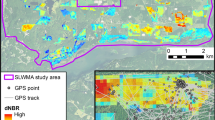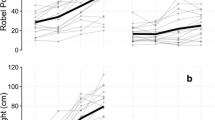Abstract
In an increasingly human-dominated landscape, effective management of disturbance-maintained ecosystems, such as grasslands and savannas, is critical to the conservation of biodiversity. Yet, the response of individual organisms to landscapes created by disturbances and management is rarely studied. In this study, we examined the endangered Karner blue butterfly, Lycaeides melissa samuelis, in a heterogeneous oak savanna. Our objective was to quantify the butterfly’s habitat use and behavior to assess the effects of prescribed burning. The oak savanna management in Ohio, USA divides each Karner blue site (n = 4) into three units. Each one-third unit is then burned, mowed, or unmanaged in an annual rotation within each site, and the result is a fire return interval of ~3 years. Our surveys measured habitat use, while behavior observations quantified reproduction and foraging for the two annual broods. Our habitat use results showed burned treatments were recolonized quickly, but there was not a clear selection for burned treatments. Foraging rates were similar in all treatments; however, females oviposited significantly less in unmanaged treatments (only 5 of 127 ovipositions). This oviposition preference was likely due to habitat degradation and the availability of recently burned, early successional habitat. Since Karner blues avoided reproduction in units unburned for ≥4 years, these units could be burned to create high quality early successional habitat. These results demonstrate how behavioral decisions can be pivotal forces driving spatial population dynamics. Our case study demonstrates how a fine-scale landscape perspective combined with measurements of behavioral processes can assist with management decision-making.



Similar content being viewed by others
References
Akcakaya RH, Radeloff VC, Mladenoff DJ, He HS (2004) Integrating landscape and metapopulation modeling approaches: viability of the sharp-tailed grouse in a dynamic landscape. Conserv Biol 18:526–537. doi:10.1111/j.1523-1739.2004.00520.x
Askins RA (2000) Restoring North America’s birds: lessons from landscape ecology, 2nd edn. Yale University Press, New Haven
Bergman KO, Kindvall O (2004) Population viability analysis of the butterfly Lopinga achine in a changing landscape in Sweden. Ecography 27:49–58. doi:10.1111/j.0906-7590.2004.03629.x
Brawn JD (2006) Effects of restoring oak savannas on bird communities and populations. Conserv Biol 20:460–469. doi:10.1111/j.1523-1739.2006.00310.x
Der G, Everitt B (2002) A handbook of statistical analyses using SAS, 2nd edn. Chapman & Hall, London
Doak DF (1995) Source-sink models and the problem of habitat degradation: general models and applications to the Yellowstone grizzly. Conserv Biol 9:1370–1379. doi:10.1046/j.1523-1739.1995.09061370.x
Elias SP, Fraser JD, Buckley PA (2000) Piping plover brood foraging ecology on New York barrier islands. J Wildl Manag 64:346–354. doi:10.2307/3803232
Ellis S (2003) Habitat quality and management for the northern brown argus butterfly Aricia Artaxerxes (Lepidoptera: Lycaenidae) in North East England. Biol Conserv 113:285–294. doi:10.1016/S0006-3207(02)00376-2
Feeny P, Stadler E, Ahman I, Carter M (1989) Effects of plant odor on oviposition by the black swallowtail butterfly, Papilio polyxenes (Lepidoptera: Papilionidae). J Insect Behav 2:803–827. doi:10.1007/BF01049402
Fraser AM, Tregenza T, Wedell N, Elgar MA, Pierce NE (2002) Oviposition tests of ant preference in a myrmecophilous butterfly. J Evol Biol 15:861–870. doi:10.1046/j.1420-9101.2002.00434.x
Fuhlendorf SD, Harrell WC, Engle DM, Hamilton RG, Davis CA, Leslie J, David M (2006) Should heterogeneity be the basis for conservation? Grassland bird response to fire and grazing. Ecol Appl 16:1706–1716. doi:10.1890/1051-0761(2006)016[1706:SHBTBF]2.0.CO;2
Gergel SE, Dixon MD, Turner MG (2002) Consequences of human-altered floods: levees, floods, and floodplain forests along the Wisconsin River. Ecol Appl 12:1755–1770. doi:10.1890/1051-0761(2002)012[1755:COHAFL]2.0.CO;2
Grigore MT, Tramer EJ (1996) The short-term effect of fire on Lupinus perennis (L.). Nat Areas J 16:41–48
Grundel R, Pavlovic NB, Sulzman CL (1998) Habitat use by the endangered Karner blue butterfly in oak woodlands: the influence of canopy cover. Biol Conserv 85:47–53. doi:10.1016/S0006-3207(97)00165-1
Haddad N (2000) Corridor length and patch colonization by a butterfly, Junonia coenia. Conserv Biol 14:738–745. doi:10.1046/j.1523-1739.2000.99041.x
Hanski I, Moilanen A, Pakkala T, Kuussaari M (1996) The quantitative incidence function model and persistence of an endangered butterfly metapopulation. Conserv Biol 10:578–590. doi:10.1046/j.1523-1739.1996.10020578.x
Harpole DN, Haas CA (1999) Effects of seven silvicultural treatments on terrestrial salamanders. For Ecol Manage 114:349–356
Huntzinger M (2003) Effects of fire management practices on butterfly diversity in the forested western United States. Biol Conserv 113:1–12. doi:10.1016/S0006-3207(02)00356-7
Jenkins CN, Powell RD, Bass OL Jr, Pimm SL (2003) Why sparrow distributions do not match model predictions. Anim Conserv 6:39–46. doi:10.1017/S1367943003003068
Johnson MD (2007) Measuring habitat quality: a review. Condor 109(3):489–504. doi:10.1650/8347.1
Klingenbock A, Osterwalder K, Shine R (2000) Habitat use and thermal biology of the “Land Mullet” Egernia major, a large Scincid lizard from remnant rain forest in Southeastern Australia. Copeia 4:931–939. doi:10.1643/0045-8511(2000)000[0931:HUATBO]2.0.CO;2
Knutson RL, Kwilosz JR, Grundel R (1999) Movement patterns and population characteristics of the Karner blue butterfly (Lycaeides melissa samuelis) at Indiana Dunes National Lakeshore. Nat Areas J 19:109–120
MacDougall AS, Turkington R (2006) Dispersal, competition, and shifting patterns of diversity in a degraded oak savanna. Ecology 87:1831–1843. doi:10.1890/0012-9658(2006)87[1831:DCASPO]2.0.CO;2
Mack GG, Clark RG (2006) Home-range characteristics, age, body size, and breeding performance of female mallards (Anas platyrhynchos). Auk 123:467–474. doi:10.1642/0004-8038(2006)123[467:HCABSA]2.0.CO;2
Mainguy J, Gauthier G, Giroux JF, Bety J (2006) Gosling growth and survival in relation to brood movements in greater snow geese (Chen caerulescens atlantica). Auk 4:1077–1089. doi:10.1642/0004-8038(2006)123[1077:GGASIR]2.0.CO;2
Meffe GK, Groom MJ, Carroll RC (2006) Ecosystem approaches to conservation. In: Groom MJ, Meffe GK, Carroll RC (eds) Principles of conservation biology, 3rd edn. Sinnauer associates inc, Sunderland, pp 467–508
Moilanen A, Hanski I (1998) Metapopulation dynamics: effects of habitat quality and landscape structure. Ecology 79:2503–2515
Morris DW, Brown JS (1992) The role of habitat selection in landscape ecology—introduction. Evol Ecol 6:357–359. doi:10.1007/BF02270697
Myers JH (1985) Effect of physiological condition of the host plant on the ovipositional choice of the cabbage white butterfly, Pieris rapae. J Anim Ecol 54:193–204. doi:10.2307/4630
NatureServe (2006) NatureServe Explorer: An online encyclopedia of life. [web application], http://www.natureserve.org/explorer Version 4.6. NatureServe, Arlington, VA
NOAA (2006) National weather service forecast office: climate data-Toledo OH. National Oceanic and Atmospheric Administration, Asheville
Noss RF, Peters RL (1995) Endangered ecosystems of the United States: a status report and plan for action. Defenders of Wildlife, Washington
Nuzzo VA (1986) Extent and status of midwest oak savanna: presettlement and 1985. Nat Areas J 6:6–36
Peterson DW, Reich P (2001) Prescribed fire in oak savanna: fire frequency effects on stand structure and dynamics. Ecol Appl 11:914–927. doi:10.1890/1051-0761(2001)011[0914:PFIOSF]2.0.CO;2
Pickens BA (2006) The consequences of a management strategy for the endangered Karner blue butterfly. MS thesis, Bowling Green State University
Pickens BA, Root KV (2008) Factors affecting host-plant quality and nectar use for the Karner blue butterfly: implications for oak savanna restoration. Nat Areas J 28:210–217. doi:10.3375/0885-8608(2008)28[210:FAHQAN]2.0.CO;2
Pickett S, White PS (1985) The ecology of natural disturbance and patch dynamics. Academic Press, San Diego
Pierce NE, Elgar MA (1985) The influence of ants on host plant selection by Jalmenus evagoras, a myrmecophilous Lycaenid butterfly. Behav Ecol Sociobiol 16:209–222. doi:10.1007/BF00310983
Pollard E, Yates TJ (1993) Monitoring butterflies for ecology and conservation, 1st edn. Chapman & Hall, London
Prudic K, Oliver J, Bowers M, Schmitz O (2005) Soil nutrient effects on oviposition preference, larval performance, and chemical defense of a specialist insect herbivore. Oecologia 143:578–587. doi:10.1007/s00442-005-0008-5
Quinn GP, Keough MJ (2002) Experimental design and data analysis for biologists. Cambridge University Press, New York
Ratti JT, Garton EO (1996) Research and experimental design. In: Bookhout TA (ed) Research and management techniques for wildlife and habitats, 5th edn. The Wildlife Society, Bethesda, pp 1–23
SAS Institute Inc (2004) Release: SAS 9.1 Edition. SAS Institute, Cary
Schultz CB (1998) Dispersal behavior and its implications for reserve design in a rare Oregon butterfly. Conserv Biol 12:284–292. doi:10.1046/j.1523-1739.1998.96266.x
Schultz CB, Crone EE (1998) Burning prairie to restore butterfly habitat: a modeling approach to management tradeoffs for the Fender’s blue. Restor Ecol 6:244–252. doi:10.1046/j.1526-100X.1998.00637.x
Swengel AB (1995) Observations of spring larvae of Lycaeides melissa samuelis (Lepidoptera: Lycaenidae) in central Wisconsin. Gt Lakes Entomol 28:155–170
Tester JR (1996) Effects of fire frequency on plant species in oak savanna in east-central Minnesota. Bull Torrey Bot Club 123:304–308. doi:10.2307/2996779
Thomas JA (1983) A quick method for estimating butterfly numbers during surveys. Biol Conserv 27:195–211. doi:10.1016/0006-3207(83)90019-8
Turner MG, Gardner RH, O’Neill RV (2001) Landscape ecology in theory and practice. Springer, New York
US Fish and Wildlife Service (2003) Karner blue butterfly recovery plan (Lycaeides melissa samuelis). Department of the Interior, U.S. Fish and Wildlife Service, Great Lakes- Big Rivers Region (Region 3)
WallisDeVries MF (2004) A quantitative conservation approach for the endangered butterfly Maculinea alcon. Conserv Biol 18:489–499
Yaacobi G, Ziv Y, Rosenzweig ML (2007) Effects of interactive scale-dependent variables on beetle diversity patterns in a semi-arid agricultural landscape. Landscape Ecol 22:687–703. doi:10.1007/s10980-006-9061-7
Acknowledgments
The Ohio Department of Natural Resources, Division of Wildlife provided funding support for this project through a State Wildlife Grant; an additional grant was provided by the Ohio Biological Survey. We are thankful for the many people who were supportive of this project: G. Haase (The Nature Conservancy), P. Tolson and C. Ellsworth (Toledo Zoo) were especially helpful. We are grateful for the data collection efforts of E. Knurek, M. Ricci, and R. Kip. J. Bouzat, C. Pickens and H. Michaels of Bowling Green State University (BGSU) provided valuable insights throughout this project. We thank H. Gee, S. Kang, P. Newell (LSU), and 2 anonymous reviewers for their revisions of the manuscript, along with M. Kaller (LSU) for statistical advice. Endangered species permits from the U.S. Fish and Wildlife Service were obtained through the Ohio Division of Wildlife. We are appreciative of the BGSU Geology Department and the BGSU Statistical Consulting Center for providing equipment and expertise.
Author information
Authors and Affiliations
Corresponding author
Rights and permissions
About this article
Cite this article
Pickens, B.A., Root, K.V. Behavior as a tool for assessing a managed landscape: a case study of the Karner blue butterfly. Landscape Ecol 24, 243–251 (2009). https://doi.org/10.1007/s10980-008-9302-z
Received:
Accepted:
Published:
Issue Date:
DOI: https://doi.org/10.1007/s10980-008-9302-z




